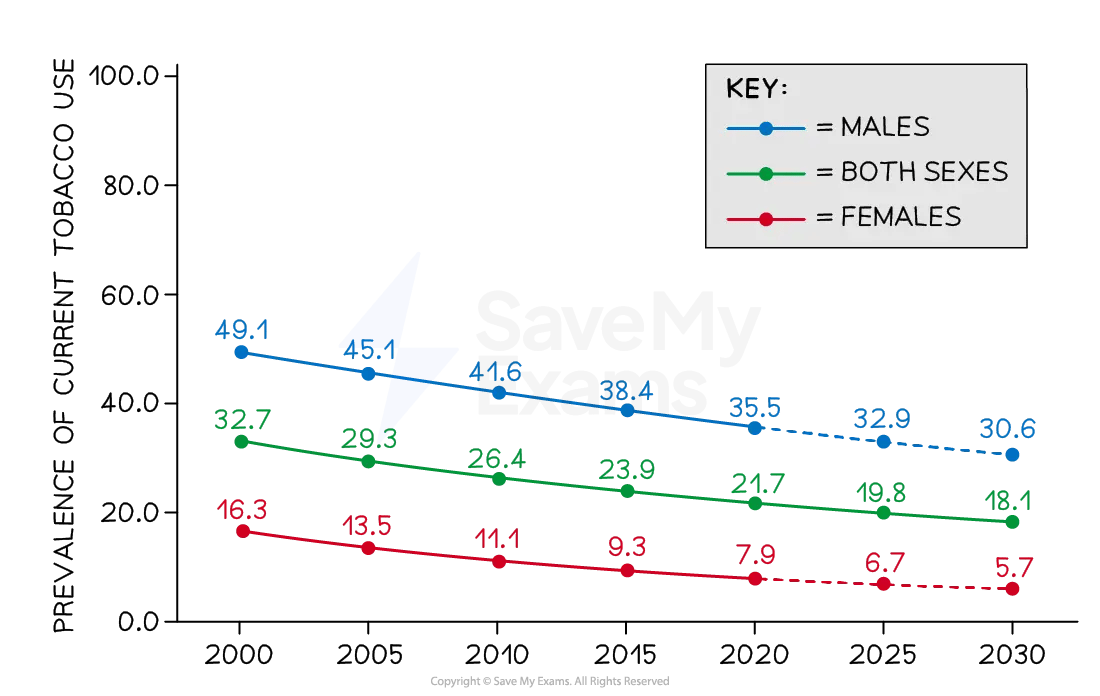Syllabus Edition
First teaching 2025
First exams 2027
Prevalence of Smoking (DP IB Psychology): Revision Note
Prevalence of smoking worldwide
Prevalence rates show how common a disorder or behaviour (e.g., smoking) is within a specific population in a given time period
It may be reported as a percentage (e.g., 5%) or as the number of cases per 10,000 or 100,000 people
Types of prevalence
There are different ways to report prevalence depending on the timeframe of the estimate:
Point prevalence – the proportion of a population smoking at a specific point in time
Period prevalence – the proportion smoking at any time during a set period (e.g., past 12 months)
Lifetime prevalence – the proportion who have smoked at any point in their life
WHO data (2024)
The World Health Organization (WHO, 2024) collects data on tobacco use:
In 2022, 20.9% of the world’s population aged 15+ smoked cigarettes
Around 80% of the 1.25 billion tobacco users live in low- and middle-income countries
The global prevalence of smoking is declining each year, but some countries (e.g., Egypt, Jordan, Indonesia) show rising rates among men (Reuters, 2024)

Prevalence of smoking: age & gender
Gender
In 2022, 34.4% of men and 7.4% of women used tobacco
In 2000, about 16.3% of women (aged 15+) used tobacco
Male-to-female ratio has widened:
In 2000 men were 3 times more likely to smoke
In 2022 men were 4 times more likely to smoke
Projected figures show that in 2030 men will be 5 times more likely to smoke
The decline in female smoking is faster than in males, but varies by region:
South-East Asia: highest female prevalence in 2000 (33%) reduced to 10% in 2022
Europe now has the highest female prevalence (18% in 2022); the decline is slower than Asia
Age
15–23 years: Approximately 13% use tobacco
45–54 years: The highest prevalence overall (18–28%)
85+ years: Approximately 13% use tobacco
After 54 years, prevalence declines as smokers age, reflecting health impacts and mortality among long-term users
Research support for prevalence of smoking
Valente et al. (2005)
Aim:
To investigate whether popular students are more likely to start smoking
Participants:
1,486 students (aged 12-14, grades 6-7) from 16 middle schools in southern California
Procedure:
Three surveys were administered to students, consisting of:
a baseline survey, measuring gender, ethnicity, age, grades, susceptibility to smoke, and smoking behaviour
a survey two months later, measuring social networks
a 1-year follow-up survey
Susceptibility to smoke was measured as a refusal to commit to never smoking in the future
Smoking was defined as 'ever puffed or smoked a cigarette'
Popularity was defined as the number of times chosen as a friend by others
Results:
Popular students were 5 times more likely to smoke than average students
Unpopular/isolated students were also more likely to be susceptible to or had already started smoking
Conclusion:
Popular students influence social norms: when they smoke, peers see it as acceptable or desirable
Because popular students are more socially connected, their influence on smoking behaviour spreads more widely
Evaluation of prevalence of smoking
Strengths
Understanding prevalence is vital due to the serious health risks of nicotine addiction
Valente’s study highlights the importance of early intervention in adolescence to reduce smoking rates
Limitations
Knowing prevalence rates is not enough — governments face challenges in implementing effective interventions
Prevalence data is descriptive, not explanatory — it does not reveal why people smoke
Smoking behaviour is complex; more qualitative research is needed to explore cultural, social, and psychological causes
Link to concepts
Change
Research shows that smoking decreases with age, which may reflect the development of health problems associated with smoking, e.g., breathing difficulties and lung and heart disease
Quitting smoking may also be a result of starting a family and not wishing to expose children to harmful tobacco smoke
Social changes (e.g., smoking bans in several countries) and increased awareness of the dangers of smoking may have contributed to prevalence rates falling
Causality
Prevalence rates can only show what is happening; they cannot explain why it is happening, which means that researchers can only infer the reasons behind a decrease in prevalence rates for smoking
There is no real way to establish cause-effect (e.g., health promotion campaigns and people quitting smoking); it is only possible to point to a relationship between certain factors and a fall in smoking prevalence generally

Unlock more, it's free!
Did this page help you?